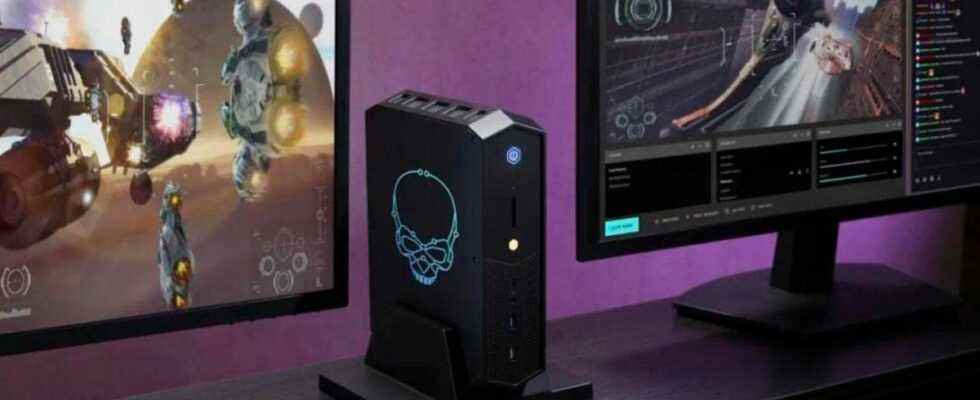3
Intel can’t keep its secrets. We discover on the occasion of a leak certain details of one of its future NUCs, called Serpent Canyon. On the program, always more power and a dedicated Intel Arc GPU.
In addition to NUCs in mini-PC format, Intel has for several years been offering NUCs designed for the practice of video games which, from iteration to iteration, never stop getting stronger… and gaining weight. As proof, the latest NUC Extremes are capable of carrying a dedicated full-length graphics card. With its Phantom Canyon on mobile architecture, the company however kept in the catalog a “small but strong” NUC offering – on the graphics power side – a mobile GeForce RTX 2060. Its evolution, Serpent Canyon, will however once again gain a few centimeters to also carry a dedicated graphics card, and not just any graphics card.
The NUC Serpent Canyon will remain much smaller than a traditional gaming tower
Indeed, we discover through first leaked visuals a more imposing NUC which, however, will not allow the user to update its components (no Compute Card here). Inside, the motherboard will house one of the most powerful laptop processors that Intel offers with its 12th Gen, namely a Core i7-12700H with 14 cores (6 performance with HyperThreading and 8 efficiency). ) capable of reaching a frequency of 4.7 GHz in Turbo. And for the first time in one of these machines, the onboard GPU will also be signed by Intel. It will be an Arc A770M graphics card, without further details. We just know that it will have a 256-bit memory bus, 16 GB of video memory and four times more compute units than the Arc A380 (whose performance is roughly equivalent to a GeForce GTX 1650).
Seeing the arrival of a small gaming machine with no component signed by AMD or Nvidia will obviously be a small earthquake. Provided of course that the performance is at the rendezvous.
Anyway, if this NUC Serpent Canyon is a little bigger, it’s obviously in order to embed a more efficient cooling system because there is no miracle: more power also means more heat release to be evacuated. We do not yet know when this future NUC will be marketed by Intel, but we hope that its availability will not suffer from shortages as has been the case in recent months for the other products in the range which, although positioned in a niche segment , are often out of stock. In terms of prices, expect a fairly high price (the Phantom Canyon is sold for around €1400).
The back side of the NUC Serpent Canyon
As usual, Intel promises to take care of the connectivity of its NUC Serpent Canyon, the visuals in question suggesting a front panel consisting of a card reader, a 3.5 mm mini-Jack, a USB port -C and two USB-A ports, plus a rear panel with three video outputs (HDMI x1 and DisplayPort x2), optical audio output, USB-C Thunderbolt port, Ethernet port 2.5 Gb and four USB-A ports. Small detail that is important: on this range of machines, the power supply (generally quite large given the power required) is external.

